

2017/06/21
Pershing’s “Does more financial services mean better? “Design Thinking! The seminar was held on June 14, 2017 in the Xia Bi Hall of Okura Prestige Hotel Taipei. It attracted about 30 VIPs and gathered financial institutions and enterprises to participate in the grand event. The event came to a successful conculusion thanks to your warm support and participation!
The rapid development of financial technology such as blockchain, P2P lending, mobile payment, and digital banking has changed the traditional financial service model. At this crucial moment, we have to as ourselves, does more mean better?
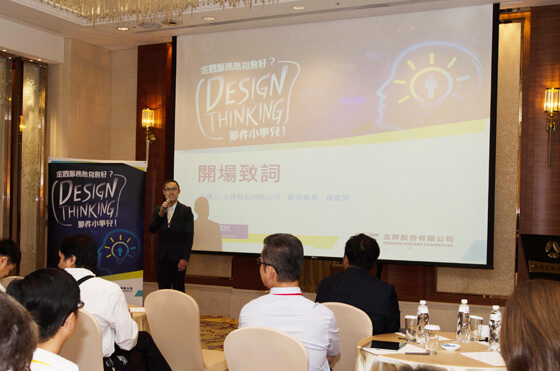
Pershing’s Vice Chairman, Chen Qinxiang, giving the opening speech.
Taking this opportunity to host this seminar, Pershing invited Xu Hao, design director of Comprad International Co., Ltd., and Yang Yahui, general manager of Junhong Data Development Co., Ltd. to discuss financial services from the perspective of users, and led participants to escape the trap of overthinking in order to return to a human-centered approach. The design spirit improves people’s lives and enhances social value. The content of the seminar included: Design Thinking in relation to Internet Banking, Combating Open Source, Hybrid Cloud, Smart Finance-Mining Secret Business Opportunities from public opinion big data, and deep learning platform of cognitive systems from IBM in Taiwan. Through public opinion analysis Pershing can get closer to the user’s viewpoint, taking into account economics combined with open-source software, and tailor-made financial services to strengthen customer ties. The result will help achieve corporate competitiveness and creativity and improve user experience and autonomy.
The vice chairman of Pershing, Chen Qinxiang, gave an opening welcome speech to kick off the seminar.
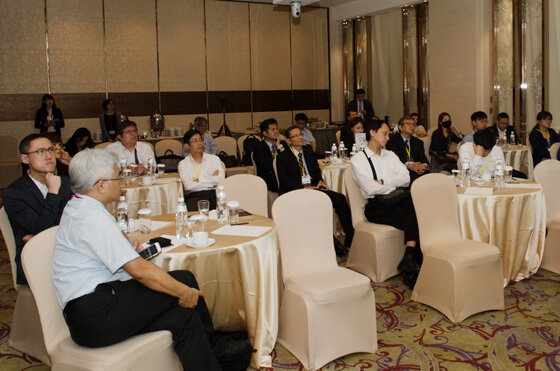
More than 30 VIPs participated, gathering financial institutions and enterprises to participate in the grand event.
The opening session was led by Wei Zhengqin, associate manager of Pershing with the theme of “Technology’s Origins: Human Nature.” Wei Zhengqin shared the design thinking of online banking, the rapid development of innovative technology, and the various service-thinking of information companies affecting future development. Functional thinking services also provide services based on experience, and service thinking must start with design thinking in order to develop people-oriented financial services. Due to people’s flexible and changeable nature, however, they may adjust their personalities and preferences from time to time due to factors such as culture, time, and geography. Pershing focuses on thinking from the perspective of users and provides them with appropriate financial services according to the trends and preferences.
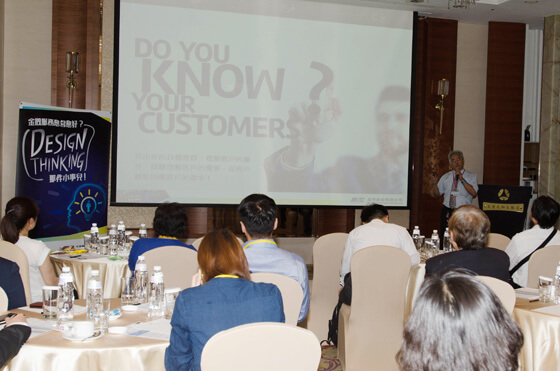
Wei Zhengqin, Associate of Pershing, shares design thinking of online banking
Quoting from Dr. Marc Prensky’s article in “Digital Natives, Digital Immigrants”, people are divided into two types: Digital Immigrants and Digital Natives. The digital immigrants’ concept stresses that there are no digital immigrants who were born before the 1980s. Due to environmental circumstances, “digital aborigines” are ethnic groups who have grown up in an environment with various digital products. What kind of target customer group does the company cater to? What are the backgrounds, attributes, needs and characteristics of the customer group? Before providing services, you need to understand what customers want by empathizing with them and their needs.
However, when referring to the demographic that uses financial services, we have to consider a wide range of users. There are consumer groups, athletes, online shoppers, stay-at-home parents, etc. Different types of users have different needs. Let’s take those in the sports industry as an example, they have a high degree of attention with regards to financial management. We can provide financial related services for this type of customer. In addition to the service project itself, the event also touched upon the use of technology and data to innovate financial services with TechFin, focusing on Mobile First and User Experience. Instead of providing more services, Pershing focuses on target customers, understanding their backgrounds and needs (Customer thinking), and provides eBanking service with high attention to emotional needs.
Next, Xu Hao, design director of the partner Comprador International Co., Ltd., shared the design concept of a new type of online banking. The current trend of online banking is to provide diversified and personalized services. However, what are the factors that make a new online bank? The seven key elements are Personalization, Transparency, Self-service, Mobile First, Material Aesthetic, Simplicity and Holistic Approach. Following up on those points mentioned by Associate Wei Zhengqin, not all platform interfaces need to have all functions, emphasizing the core concept of “every platform and interface has different characteristics and requirements, and a particular platform doesn’t need to be an end-all-be-all, but it needs to fulfill the needs according to the demographic it’s servicing.”
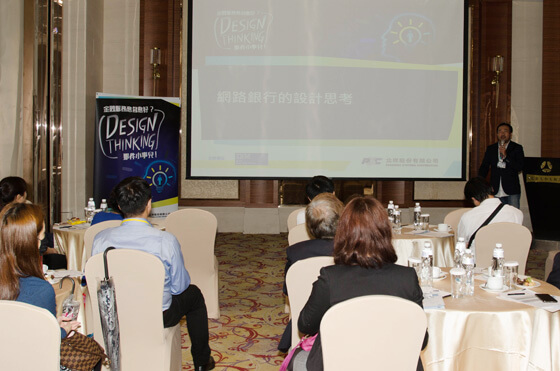
Xu Hao, Design Director, Comprad International Co., Ltd. shares the design concept of a new online banking.
The previous model of online banking is not only unable to be used on mobile devices, but also complex content is not easy to maintain, and the maintenance costs are expensive due to outdated technology. If you think from a design perspective, you can find problems, formulate strategies, and propose design solutions to solve these problems. Through data analysis, we need to research questions such as: How do people use online services? What do people need? Simplify complex functions with customized strategies, and only provide users with the services they need. Pershing builds upon previous design experience to provide online banking users a personalized page that allows users to choose and customize their own usage mode. From the design viewpoints of foreign online banking, to the analysis of past online banking experience, sharing the key elements of online banking design, it’s clear that services should be simplified and adapted to fit the present and future. All of these elements help to design strategy for future online banking.
For the next part of the agenda, Pershing Associate, Guo Taiyuan, shared the counter argument to open source, internal and hybrid cloud. In addition to diversified and customized financial services, the cloud application architecture brings flexible scheduling and can also improve IT efficiency, laying the foundation for a company’s technology roots and development. How to use Open Source to build cloud services? What are the regulations on cloud services? With Pershing’s team of professionals, the integrated multi-service design hybrid cloud is the focus of enterprise cloud planning. From architecture planning, analysis on demand, services focus on scenario analysis and provision analysis through portal mechanism and data management. The provision of services includes different types of mechanisms, fault tolerance and data preservation, digital content management, data retrieval, cloud hard drives, etc.. Through use of Open Source technologies such as Solr and Cassandra Pershign is able to integrate hybrid clouds and create multiple services.
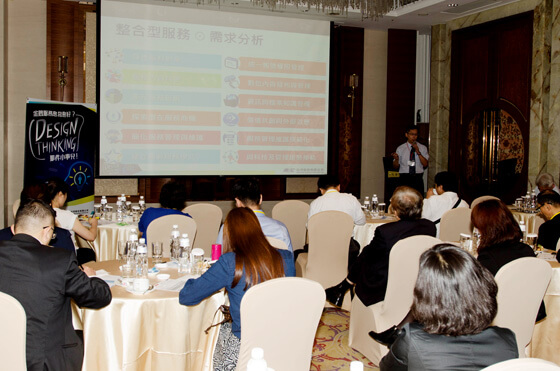
Guo Taiyuan, Associate of Pershing shares the counter argument to open source, internalized and hybrid cloud.
In the first half, the seminar focused on the user’s experience of systematic optimization and the development of financial services; however, we also had to take into account what users were thinking. How do we get close to the user’s vision through public opinion analysis? Yang Yahui, general manager of Junhong Data Development Co., Ltd., shared smart finance-mining secret business opportunities from public opinion and big data. Due to changes in population structure and usage habits, traditional survey methods are not fully applicable. According to government public information and Jun Hong’s survey, about 20% of households in Taiwan do not have land lines. Although the remaining 80% have them, most do not use them. Any sort of phone survey will yield results that are biased towards a small percentage of the populace. Therefore, when investigating different age groups, commonly used devices should be used as survey tools. For example, demographic groups reached by telephone surveys can target people over the age of 50; while complementary survey methods can use mobile devices to conduct surveys to people under this age group.
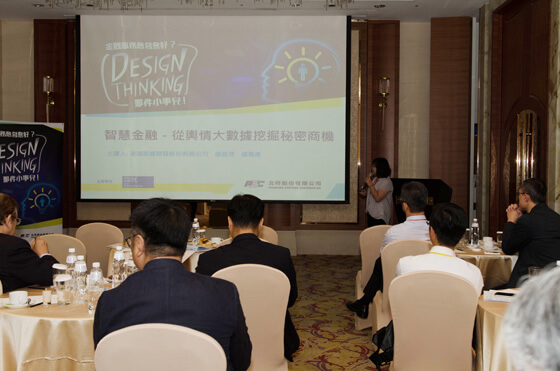
Yang Yahui, General Manager of Junhong Data Development Co., Ltd. Sharing Smart Finance-Mining Secret Business Opportunities from Public Opinion Big Data.
In the day and age where social media reigns supreme, Sumin’s opinions are in the limelight. Companies are facing community public relations crises at a fast speed and with a wide range of outbreaks. Online public opinion/community data can help companies conduct competition monitoring, crisis warnings, opinion surveys, and industry innovations. In the development of news and business opportunities, many companies focus on brand image. They can use public opinion management to monitor distributors, suppliers, competitors, consumer markets and industries, and even spokespersons, so as to grasp first-hand real information and understand what they are facing. Through use of social media, mobile devices, and modern technology, data can be conveniently collected. Ideas for formulating how to deal with any sort of crisis are brainstormed now at breakneck speed, and the source of crises are spotted much more quickly.
The early Internet public opinion system used keywords as data screening, which may have a strong effect on personnel detection, but there will be many bottlenecks due to excessive information, with over 10,000 keywords of data in the mix, making it challenging for analysis of incidents. This challenge results in less than 20% of the data is meaningful for this analysis. In addition to the public opinion analysis system, it is also necessary to deploy text exploration technicians to produce analysis reports, which is time-consuming and limited by human capacity and manpower. Therefore, innovative public opinion analysis methods have been developed, which can not only automatically scan text clusters and remove excess “noise,” but also provide early warnings of related events, automatic semantic analysis, and even provide decision-making suggestion lights to help companies get close to users’ vision through public opinion data in real time.
In addition to design thinking, application architecture and public opinion information also strengthen financial services. How can we use artificial intelligence to gain the competitive edge? Que Zhiming, senior technical associate of the hardware system department of IBM, Taiwan, introduced the deep learning platform on Cognitive Systems and shared the development of artificial intelligence and IBM’s Watson robot for cognitive computing. These developments represented the most advanced results in the field of artificial intelligence, and use a variety of technologies including strategy analysis, statistical analysis, and machine learning. Among them, “deep learning” technology has been used in computer vision and natural language in recent years. Advanced development, emphasizing machine understanding, reasoning, and learning capabilities of cognitive computing, based actual business scenarios. Through use of these new developments it is clear that customers are better equipped to solve specific business problems.
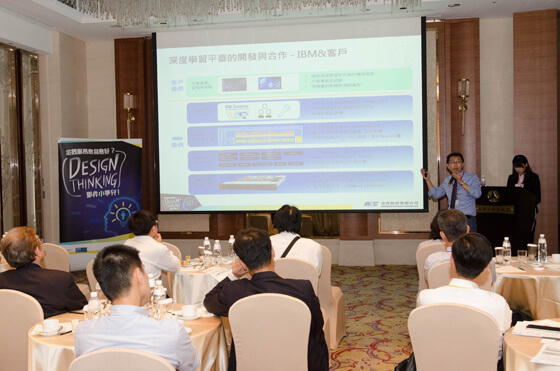
Que Zhiming, Senior Technical Associate, IBM Hardware Systems Department, Taiwan Introducing the deep learning platform on Cognitive Systems
Application examples in the analysis of structured and semi-structured data in the financial and insurance included: futures index forecasting, VIP customer turnover rating alerts, image data analysis such as online account opening review, bill recognition and classification, credit card recognition, and even ATM face masking and file detection, etc. Deep Learning on Cognitive System provides flexible options to deploy the best AI/ML/DL solutions that are integrated with open architecture, and develops smart financial technology services through the industry. We hope everyone can partake in the benefits of Design Thinking Financial services to better achieve user competence!
Pershing started from the branch system to online banking and mobile banking. So far, it has more than 20 years of system development and construction experience. With “Design Thinking” as the core of design and development, it creates the value of financial services to meet the needs of users and facilitate customer business. Development, not only for manufacturing, but also for ideas, tailor-made financial services to strengthen customer satisfaction, improve people’s lives, enhance social value, realize corporate competitiveness and creativity, and continue to create financial services! Welcome to obtain the complete briefing materials of the day’s events. Please contact Ms. Liu of Pershing (02-2658-1910 ext 2406; metaliu@pershing.com.tw), or browse Pershing’s website for further information.